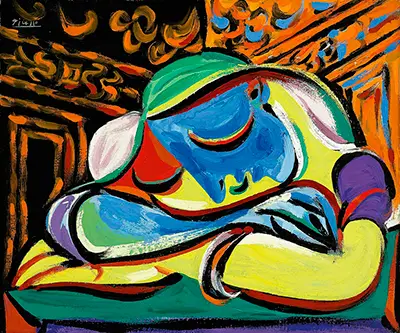The painting, in the year 2018, is 83 years old. Pablo Picasso painted it as one of the many paintings that the Spanish painter ever made of his young lover, Marie-Thérèse Walter.
The two, Marie-Thérèse Walter and Pablo, had a passionate romance that resulted in great art pieces, true to Pablo’s promise to her.
History has it that the middle-aged man saw the young Marie and got infatuated. Immediately, he grabbed her by the arm and asked her to go with him.
He promised that is she did; they would do great things together. To honour his promise, Pablo immortalised Marie-Thérèse Walter by making paintings of her that would later come to be traded for 13.5 million for just one of the many pieces they made together.
The painting portrays a graceful and peaceful Marie-Thérèse having a nap. It focuses on her sleeping head while her body is painted in an array of colours, all carefully and incandescently conjured and arranged. The oil and canvas painting is rich in colours that are vividly cast on the canvas, complemented with sinuous lines of curve.
The sinuous curve lines are intricately used to give the essence of subtle sexuality infused with innocence. The feeling of sexuality and innocence infused draw the idea that Picasso had sexual encounters or desires for the lady but he did not only lust after her; he had graceful feelings of legitimate care for her.
The curve lines also seamlessly curve out a subtle smile and peace that emanates from within her implying the feelings of love and peace that were in her thoughts when the painting captured her.
The painting shows Marie sleeping in her arms, an indication of good health and strength as she did not need external support even in her sleep. The intimate details set apart in contrasting colours show how keenly and peacefully Picasso observed her, a concept alien to conflicting lovers. One can observe Marie’s hair which is parted in the middle. Again, two different colours manifest the two halves of the hair.
The picture actually seems bigger than it is, an illusion that Pablo accomplishes by using vibrant colours. His colour choices are also ingenious in that apart from making the painting look grandiose with his bright colour schemes. The colour scheme is also instrumental in accentuating the curve lines that exaggerate her upper eyelids and plump cheeks. The colour scheme employed is also symbolic: the yellow symbolises joy and hopeful optimism, the purple is romantic and the blue standards for confidence.
The Jeune Fille Endormie was sold to a French owner who lent to a museum in New York back in 1939. It later came to be donated to the University of Sydney by an American owner on condition that it would be auctioned off to raise money for research. It fetched a price of £13.5 million for the university at an auction. The oil and canvas painting is 55 centimetres long and 46.3 centimetres wide.
Most movers and shakers in the art scholarly world consider Pablo Picasso to be the most important art contributor in the 20th century. He had already become the most famous modern art painter before the clocked 50years of age. The Spaniard spent his career in France where he created over 20,000 ceramics, sculptures, paintings and drawings. He was deeply involved in theatre affairs where he created props and designed costumes. He was deeply respected for his versatile artistic nature because he bested many artists in different art styles. Pablo Picasso was innovative with idealistic convictions.
Together with Georges Braque, he cofounded the Cubist movement. The art style breaks art pieces into fragments which are rearranged into an abstract form. The art style, Cubism, drastically changed the face of European painting and had a butterfly effect that trickled into music, architecture and sculpture, and literature. Apart from the Cubist movement, he is also credited to for being the force that gave life to the constructed sculpture and the collage art style. He also made great contributions towards defining the elements of plastic arts.

